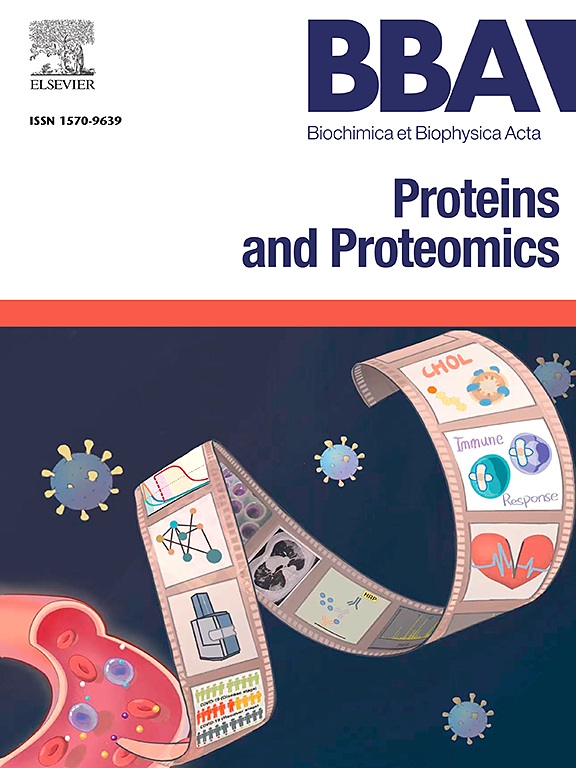Tracking heme biology with resonance Raman spectroscopy
IF 2.3
4区 生物学
Q3 BIOCHEMISTRY & MOLECULAR BIOLOGY
Biochimica et biophysica acta. Proteins and proteomics
Pub Date : 2025-02-23
DOI:10.1016/j.bbapap.2025.141065
引用次数: 0
Abstract
Heme proteins are a large group of biomolecules with heme incorporated as a prosthetic group. Apart from cytochromes present in almost all cell types, many other specific heme proteins are expressed in different kinds of cells, e.g. hemoglobin in the erythrocytes, myoglobin (skeletal and vascular smooth muscle cells), cytoglobin (fibroblasts) and neuroglobin (neurons and retina). Among their wide and diverse biological functions, the most important is their unique ability to bind, store, and transport gaseous molecules, such as oxygen, carbon monoxide, and nitric oxide. Resonance Raman (RR) spectroscopy is an exceptional analytical tool that allows for qualitative and quantitative characterization of heme proteins in biological systems. Due to its high sensitivity, even subtle structural alterations of the heme group can be monitored and tracked during cellular processes. Resonance Raman excitation within the Soret absorption band (390–440 nm) provides rich information on the environment of heme's active site, allowing differentiation of the iron ion oxidation and spin states, and tracking the movement of the porphyrin ring plane in response to the changes in oxygenation status. Herein, we summarize and discuss recent developments in RR applications aimed to link the structure-function relationship of heme proteins within biological systems, connected, e.g., with the formation of hemoglobin (Hb) adducts (nitrosylhemoglobin, cyanhemoglobin, sulfhemoglobin), irreversible Hb alterations deteriorating oxygen binding and differentiation of heme proteins oxidation state within live cells in situ.
用共振拉曼光谱跟踪血红素生物学。
血红素蛋白是一大类以血红素为假体的生物分子。除了存在于几乎所有细胞类型中的细胞色素外,许多其他特定的血红素蛋白在不同类型的细胞中表达,例如红细胞中的血红蛋白、肌红蛋白(骨骼和血管平滑肌细胞)、细胞红蛋白(成纤维细胞)和神经红蛋白(神经元和视网膜)。在它们广泛而多样的生物功能中,最重要的是它们结合、储存和运输气态分子(如氧气、一氧化碳和一氧化氮)的独特能力。共振拉曼光谱是一种特殊的分析工具,可以对生物系统中的血红素蛋白进行定性和定量表征。由于其高灵敏度,即使是细微的结构改变血红素组可以监测和跟踪在细胞过程中。Soret吸收带(390-440 nm)内的共振拉曼激发提供了血红素活性位点环境的丰富信息,允许铁离子氧化和自旋状态的区分,并跟踪卟啉环平面响应氧合状态变化的运动。在此,我们总结并讨论了RR应用的最新进展,旨在将血红素蛋白在生物系统中的结构-功能关系联系起来,例如与血红蛋白(Hb)加合物(亚硝基血红蛋白、氰化血红蛋白、亚硫酸盐血红蛋白)的形成、不可逆的Hb改变、氧结合恶化以及活细胞内血红素蛋白氧化状态的分化有关。
本文章由计算机程序翻译,如有差异,请以英文原文为准。
求助全文
约1分钟内获得全文
求助全文
来源期刊
CiteScore
8.00
自引率
0.00%
发文量
55
审稿时长
33 days
期刊介绍:
BBA Proteins and Proteomics covers protein structure conformation and dynamics; protein folding; protein-ligand interactions; enzyme mechanisms, models and kinetics; protein physical properties and spectroscopy; and proteomics and bioinformatics analyses of protein structure, protein function, or protein regulation.

 求助内容:
求助内容: 应助结果提醒方式:
应助结果提醒方式:


